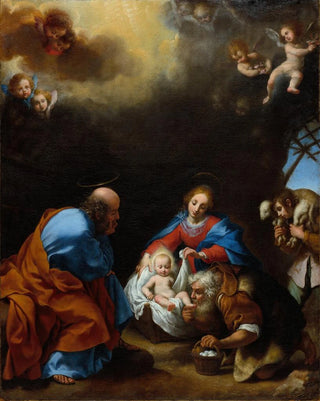Art print | Adoration of the Shepherds - Carlo Dolci


View from behind

Frame (optional)
The "Adoration of the Shepherds" by Carlo Dolci is an iconic work of Italian Baroque art, a painting that evokes the tenderness and warmth of a sacred moment. This scene, where shepherds come to pay homage to the Child Jesus, is imbued with an atmosphere of peace and devotion. The characters, depicted with great delicacy, seem to capture the very essence of faith and wonder. Through this art print, Dolci invites us to contemplate the beauty of the scene while immersing ourselves in a spiritual universe where every gaze, every gesture, is filled with meaning. The soft light bathing the composition creates an intimate connection between the figures and the viewer, making this art print an emotionally powerful piece.
Style and uniqueness of the work
Carlo Dolci's style is characterized by meticulous attention to detail and a palette of delicate colors that give his works an almost mystical quality. In the "Adoration of the Shepherds," the faces of the characters are imbued with rare expressiveness, each expression revealing psychological depth. The drapery of the clothing, carefully crafted, seems almost alive, adding a tactile dimension to the scene. The composition, well balanced, guides the viewer's eye toward the center of the work, where the Child Jesus rests peacefully. The use of light, subtly illuminating the faces while casting the background in a gentle shadow, enhances the intimacy of this adoration. Dolci, through his approach, manages to transcend simple representation to offer a unique visual and spiritual experience.
The artist and his influence
Carlo Dolci, born in Florence in the 17th century, is one of the masters of Italian Baroque. His career, although less well-known than that of some of his contemporaries, has left an indelible mark on art history. Dolci was recognized for his ability to fuse the sacred and the profane, creating works that speak to both the mind and the heart. His influences range from the great masters of the Renaissance to Florentine traditions, but he developed a style that is uniquely his own, characterized by a

Matte finish

View from behind

Frame (optional)
The "Adoration of the Shepherds" by Carlo Dolci is an iconic work of Italian Baroque art, a painting that evokes the tenderness and warmth of a sacred moment. This scene, where shepherds come to pay homage to the Child Jesus, is imbued with an atmosphere of peace and devotion. The characters, depicted with great delicacy, seem to capture the very essence of faith and wonder. Through this art print, Dolci invites us to contemplate the beauty of the scene while immersing ourselves in a spiritual universe where every gaze, every gesture, is filled with meaning. The soft light bathing the composition creates an intimate connection between the figures and the viewer, making this art print an emotionally powerful piece.
Style and uniqueness of the work
Carlo Dolci's style is characterized by meticulous attention to detail and a palette of delicate colors that give his works an almost mystical quality. In the "Adoration of the Shepherds," the faces of the characters are imbued with rare expressiveness, each expression revealing psychological depth. The drapery of the clothing, carefully crafted, seems almost alive, adding a tactile dimension to the scene. The composition, well balanced, guides the viewer's eye toward the center of the work, where the Child Jesus rests peacefully. The use of light, subtly illuminating the faces while casting the background in a gentle shadow, enhances the intimacy of this adoration. Dolci, through his approach, manages to transcend simple representation to offer a unique visual and spiritual experience.
The artist and his influence
Carlo Dolci, born in Florence in the 17th century, is one of the masters of Italian Baroque. His career, although less well-known than that of some of his contemporaries, has left an indelible mark on art history. Dolci was recognized for his ability to fuse the sacred and the profane, creating works that speak to both the mind and the heart. His influences range from the great masters of the Renaissance to Florentine traditions, but he developed a style that is uniquely his own, characterized by a






